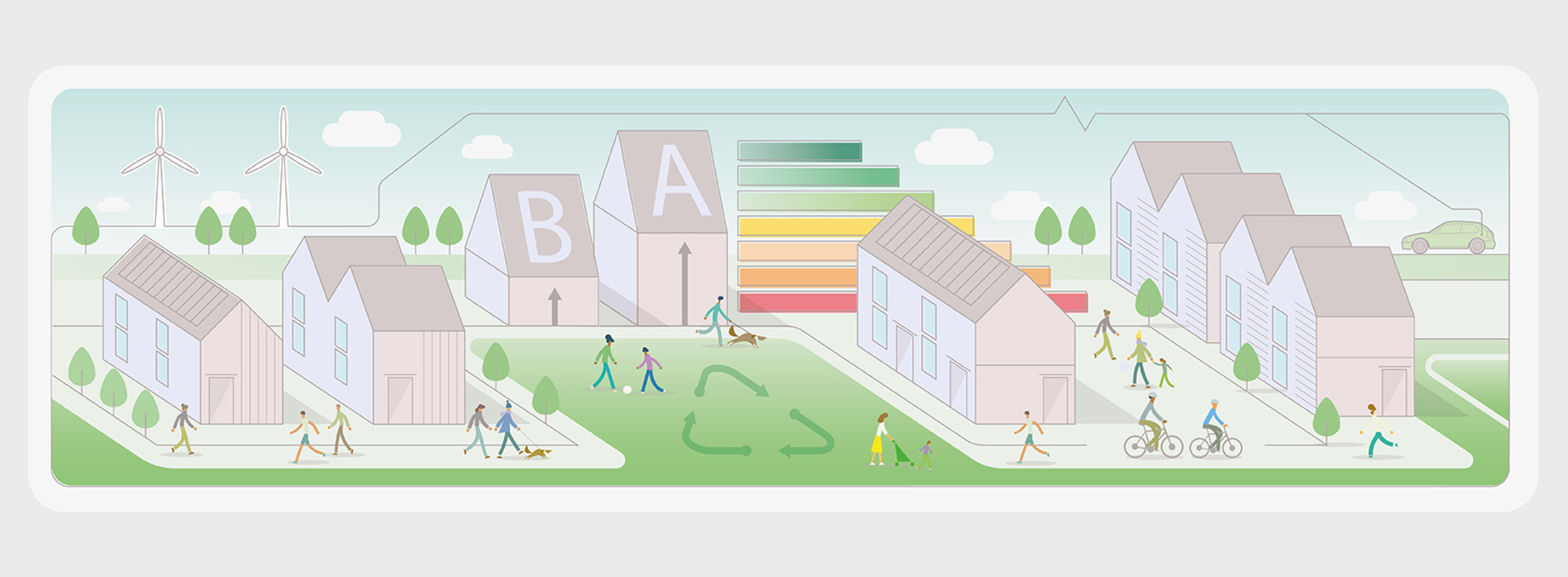Consumer sentiment is increasing towards more sustainable ‘green’ homes but only larger homes achieve a ‘green’ premium
Consumers are increasingly conscious of the sustainability of their homes. But it is typically still only the most affluent eco-conscious buyers who are prepared to pay more for a ‘green’ home. And it’s only larger homes that achieve a ‘green’ premium. As the market is not yet able to generate enough demand for more sustainable homes, the question is how to generate the demand and cover the additional cost to build these homes. Better mortgage rates for more energy-efficient homes may help increase demand. But changes to government policy and incentives such as stamp duty exceptions could be used to increase demand, support delivery and ensure we are on track to meet the zero-carbon target.
Increasing consumer awareness of sustainable homes
There is increasing awareness of sustainable products and more energy-efficient homes. 49% of buyers surveyed by Savills in 2020 stated green credentials had become more important. And 29% of new homes buyers surveyed by Redrow said that energy efficiency was the most important factor in choosing a home.
But, are buyers prepared to pay for a more sustainable home? Several studies have found that buyers are only prepared to pay a small amount for sustainable features:
- A report published earlier this year by Gowling WLG found that homebuyers are prepared to pay an extra £2,800 for 'green features' with cost savings and higher resale values being key incentives for doing so.
- Older academic research by Mandell and Wilhelmsson in 2011 found that in Sweden there is a positive willingness to pay for environmental housing attributes but lower-cost features were far more appealing than higher-cost ones.
- This was also found to be true in 2007 Savills research which found most UK households do consider ‘green’ issues to be important but few are prepared to pay more for measures that reduce environmental impact.
Few ‘green’ homes
Part of the challenge in assessing whether there is a ‘green premium’ is that relatively few homes have been built to the highest energy efficiency and sustainability standards. Back in 2006, The Code for Sustainable Homes was launched to help reduce UK carbon emissions and create more sustainable homes. However, the code was not mandatory and very few homes have been built to the highest standards.
Only one of the 15 eco-towns shortlisted in 2008 have been built (Elmsbrook). Just 1% of both new homes built since 2011 and those sold in the last year in England and Wales were EPC A-rated. Almost all were B-rated, just scraping above required levels.
Is there a premium?
From the evidence we have at the moment, we find there is typically only a ‘green’ premium for larger new homes. But these premiums are often achieved as part of a wider package of high-quality features. In time, as more energy-efficient and sustainable homes are built we will be able to test whether a premium evolves.
In both these examples we have controlled for location and date of sales. But the quality of the design of the home, outside space and living environment also have an effect on the price paid. So the energy efficiency and sustainability only partly contribute to the premium. This has been true on smaller developments of sustainable homes too. Here developers have also often had to accept a slower sales rate to achieve the values (and premiums) they need to cover the additional build costs.
We find there is typically only a ‘green’ premium for larger new homes, although these premiums are often achieved as part of a wider package of high-quality features
Lucy Greenwood, Director, Residential Research
Who buys green homes?
Due to the higher pricing of more sustainable home and the affordability pressures on housing, it tends to be the more affluent eco-conscious who buy them. As we showed in our analysis from ‘The appeal of energy-efficient housing’, those buying higher-priced homes were the ones buying more energy-efficient homes.
New analysis here simply comparing who lives in EPC A- and B-rated homes shows that it’s the established families (41–60-year-olds with children) who have a greater propensity to live in an A-rated home than a B-rated one. It is this group that tend to buy larger homes (average 1,200 sq ft) and have greater spending power.
The challenge for delivering more sustainable homes
The Government’s intention is for all new homes to be zero-carbon by 2050 and produce 75–80 per cent reduction in carbon emissions by 2025. To achieve this homes will cost more to build. The extra cost may need to be paid by the home buyer through higher house prices, the developer through lower margins and/or the landowner through lower land values.
This research has found there is a limited premium for ‘green’ homes as the pressures of affordability on the housing market mean most buyers don’t have the luxury of choosing the additional ‘green’ features. Buyers are typically only prepared to pay a small contribution (if any) towards such features even though there is growing consumer awareness of sustainability issues.
Affordability is unlikely to go away as a constraint. But it is possible that mortgage terms for more energy-efficient properties, which are already emerging (see ‘Is there green finance pressure on housebuilders to decarbonise?’), will start to drive a higher premium or brown discount. Until an established premium emerges, it remains unclear whether it will be financially viable to maintain and increase levels of housing supply at the energy efficiency standards that are needed, or whether other policies and government interventions will have to be flexed. Could the introduction of a stamp duty exemption or a grant to the developer or home buyer for the most energy-efficient homes be part of the solution? Similar incentives have significantly boosted the demand for electric vehicles.
View our latest Development and Planning Insights here.
